Amplifying unit of amateur radio complex
Main specifications of the power amplifier:
Rated output power, W, .......................... 2x25 (2x60)
Power band, kHz ....................................... .02 ... 150 (100)
Rated input voltage, V .................................... 1 (1)
Harmonics factor,%, at frequency, kHz:
1 .............................................................................. 0,1(0,1)
2 ............................................................................ 0,14(0,55)
10 ............................................................................ 0,2(0,9)
20 ............................................................................. 0,35(1,58)
Coefficient of intermodulation distortion,%, ......... 0.3 (0.47)
Input resistance, kΩ .................................................. . 150
Quiescent current of the output stage, mA ......................................... 50 (50 )
The cascade of voltage amplification of the signal is executed on the op-amp A1. As can be seen from the diagram, a part of the output signal is fed to the circuit of its supply through the circuit R6C3C4R4R5 (together with zener diodes V6, V7 the elements of this circuit, in addition to the resistor R6, stabilize and filter the supply voltages). As a result, the voltages at the power terminals of the op amp at the maximum signal are shifted (relative to the common wire) to the corresponding side and the amplitude of the output signal of the op-amp is significantly increased. The large common-mode signals that arise at the input of the op-amp do not pose a danger, since the op-amp suppresses them well (typical attenuation factor is 70 ... 90 dB). When a signal is applied to the inverting input, the stabilized supply voltages should not exceed + -28 V, on inverting inputs the value equal to (11in + 28 V), where 11in is the amplitude of the input signal. In any case, the unused input must be connected to the common wire. OU К140УД8А into power amplifiers can be replaced with К140УД8Б, К140УД6, К140УД10, К140УД11, К544УД1. The worst results are obtained using the O1 K140UD7. It is not recommended to use OU К140УД1Б, К140УД2А, К140УД2Б, К153УД1. Instead of zener diode KS518A, it is possible to use zener diodes D814A, D814B with a common stabilization voltage of about 18V.
High-quality ULF
The amplifier described below is suitable for amplifying powerful audio signals in high-end audio reproducing devices, as well as for use as a powerful broadband operational amplifier.
The main technical characteristics of the amplifier:
Nominal output power, W, at load resistance,
Ohms: 8 ............................................... ............................................ 48
4..........................................................................................60
The range of reproduced frequencies with a non-uniformity of the amplitude-frequency characteristic is not more than 0.5 dB and the output power is 2 W, Hz .................. 10 ... 200000
The coefficient of nonlinear distortion at rated power
in the range 20 ... 20000 Hz,% ........................................ ............ .05
Rated input voltage, V .................................. 0.8
Input resistance, kΩ .................................................. ........ 47
Output impedance, Ohm .............................................. .... 0.02
The input stage of the amplifier consists of two differential amplifiers (connected in parallel) made on transistors VT1, VT3 and VT2, VT4 of the opposite structure. Current generators on transistors VT5, VT6 provide stability of values (about 1 mA) of total emitter currents of differential pairs, as well as isolation on power circuits. The signal to the output amplifier is supplied from controlled current generators (VT7, VT7), which work in phase. This inclusion increased the current "buildup" by half, reduced the nonlinear distortion and improved the frequency characteristics of the amplifier as a whole. Each of the arms of the symmetrical output amplifier is made according to the Darlington circuit, and is a three-stage amplifier (in two cascades the transistors are connected in a common emitter circuit and in one with a common collector). The amplifier is covered by a frequency-dependent OOS, which determines its transmission coefficient for voltage, which is close to three in the audio range. Since the feedback signal, taken from the resistor R39 (R40), is proportional to the changes in the current of the output transistor, a rather stiff stabilization of the operating point of this transistor is additionally performed. The offset voltage of the output stage is determined by the collector-emitter impedance of the transistor VT9 and is controlled by the resistor R24. The bias voltage is thermostabilized by the diode VD4, which is fixed to the heat sink of one of the powerful transistors.
The correction elements R16, C4, C6-C11 provide the stability of the amplifier and equalize its frequency response. Passive low-pass filter R2C1 prevents the input of radio frequency signals. The chain C12R45L1R47 compensates the reactive component of the load resistance. On the transistors VT12 and VT13 a node for protecting the output transistors from current and voltage overloads is assembled. Resistor R1 allows, if necessary, to limit the output power in accordance with the level of the signal from the preamplifier and the capabilities of the applied loudspeaker.
In the amplifier, you can use other low-power high-frequency silicon transistors, for example, KT342A, KT342B and KT313B, KT315 and KT361 (with indices from B to E). Transistors VT14 and VT15 (possible replacement - KT816V, KT816G and KT817V, KT817G or KT626V and KT904A) are equipped with finned heat sinks of dimensions 23x25x12 mm. As output you can use transistors KT818GM and KT819GM, which allow you to receive power over 70W with increasing supply voltage. The Zener VD1 can also be D816G or 2S536A, VD2 and VD3 - KC147A (with the corresponding correction of resistors R11 and R14).
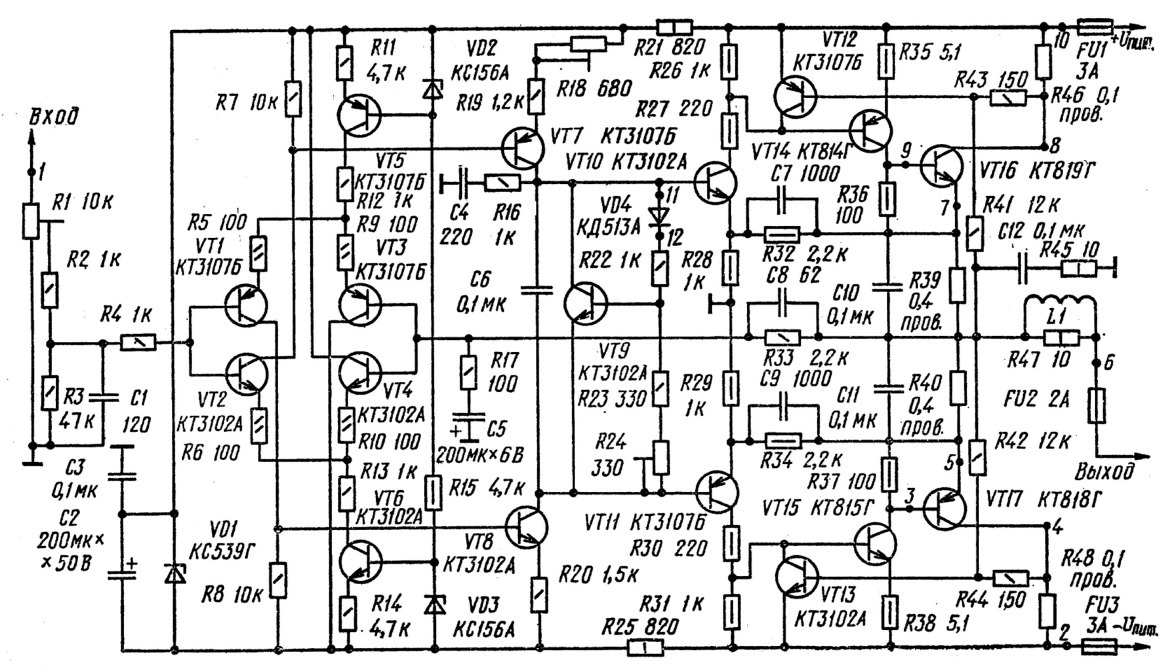
Power amplifier
Nominal (maximum) power, W ..................... 60 (80)
Nominal frequency range, Hz ...................... 20 ... 20000
Harmonic coefficient in the nominal frequency range,% 0.03
Rated input voltage, V ... 0.775
Output impedance, Ohm, not more than ................................. .08
Rate of increase in output voltage, V / μs ............. 40
The main voltage gain is provided by a cascade at the high-speed DA1 DA. The preamp amplifier stage is assembled on transistors VT1 - VT4. Unlike the prototype, an output emitter follower made on transistors VT5, VT6 operating in the "B" mode is added to the described amplifier. The temperature stability is achieved by incorporating resistors R19, R20 in the transistors VT3, VT4 into the collector circuits. Each shoulder of the pre-cascade cascade is covered by a chain of local OOS with a depth of at least 20 dB. The voltage of the OOS is removed from the collector loads of transistors VT3, VT4 and through the dividers R11R14 and R12R15 is fed to the emitter circuits of transistors VT1, VT2. Frequency correction and stability along the OO circuit is provided by the capacitors СЮ, С11. Resistors R13, R16 and R19, R20 limit the maximum currents of the pre-term and final stages of the amplifier in case of a short-circuit of the load. At any overloads, the maximum current of transistors VT5, VT6 does not exceed 3.5 ... 4 A, and in this case they do not overheat, since the fuses FU1 and FU2 have time to burn and switch off the power of the amplifier.
Reduction in the harmonics ratio is achieved by introducing a deep (not less than 70 dB) total OOS, the voltage of which is removed from the amplifier output and fed to the inverting input of the DA DA1 via a divider C3C5R3R4. The capacitor C5 corrects the amplitude response of the amplifier along the OOS circuit. The R1C1 circuit included at the amplifier input limits its bandwidth to 160 kHz. The maximum possible linearization of ACHMUCH in the band 10 ... 200 Hz is achieved by a suitable choice of the capacitance of capacitors C1, С3, С4.
Instead of those indicated on the diagram, you can use the K574UD1A, K574UD1V OU and transistors of the same types as in the diagram, but with the indices G, D (VT1, VT2) and B (VT3 - VT6).
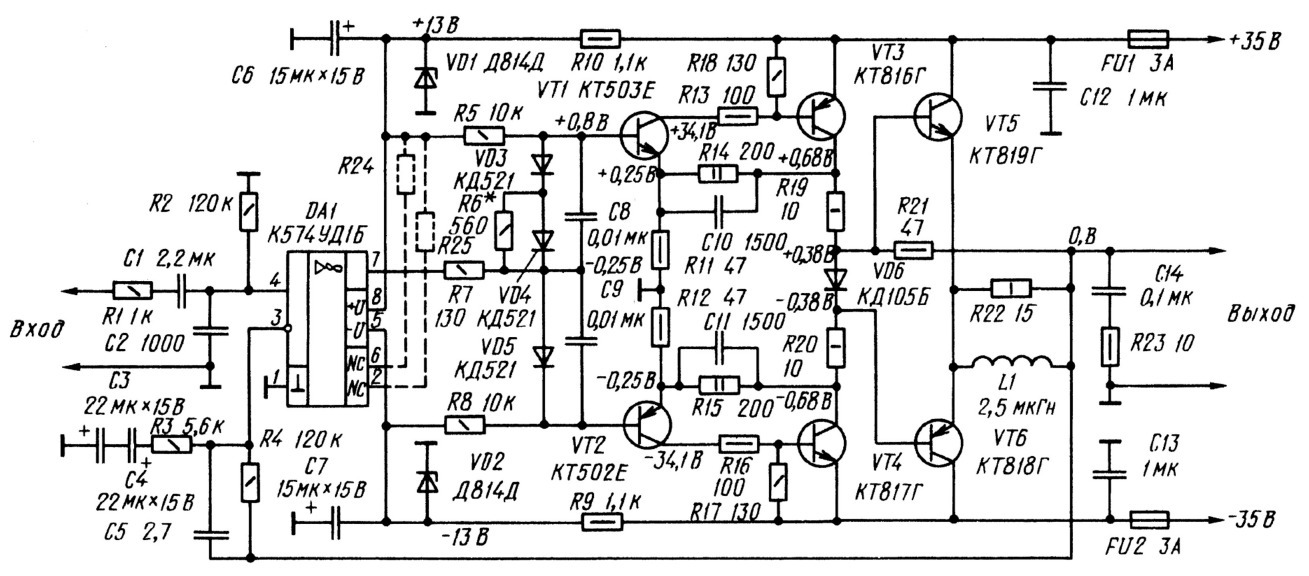
UmzCH with output stage on field-effect transistors
Main technical characteristics:
Rated (maximum) output power, W .. 45 (65)
Harmonic coefficient,%, not more, .................................... .01
Nominal input voltage, mV .................................. 775
Nominal frequency range, Hz, ......................... 20 ... 100000
Rate of increase in output voltage, V / μs, ................ 60
Signal-to-noise ratio, dB .................................... ......... 100
The input stage of the amplifier is made on the DA1 DA. To increase the amplitude of the output voltage, control of the output transistors UMZCH on the power supply circuits of the op-amp is applied. The output signal is removed from the positive output of the DA1 power supply and through the VT1 transistor included in the circuit with the OB, it is applied to one of the inputs of the differential stage on the transistors VT2, VT4. Its second input receives a stabilized voltage from the divider formed by the diodes VD2 - VD5 and the resistor R13.
The described amplifier does not require taking any special measures to protect the output transistors from short circuits in the load, since the maximum voltage between the source and the gate is only twice that of the rest voltage and corresponds to the current through the output transistor of about 9 A. This current the applied transistors are reliably maintained during the time that is necessary to burn out the fuses and shut off the UMZCH from the power source.
The coil L1 is wound in one layer on a toroidal framework with an outer diameter of 20, an internal 10 and a height of 10 mm and contains 28 turns of a PEV-2 wire 1.0.
It is advisable to use the KR544UD2A op-amp as the most wideband domestic op-amp with internal frequency correction. Transistors KT3108A are replaceable KT313A, KT313B, and KP912B - KP912A and KP913, KP920A. 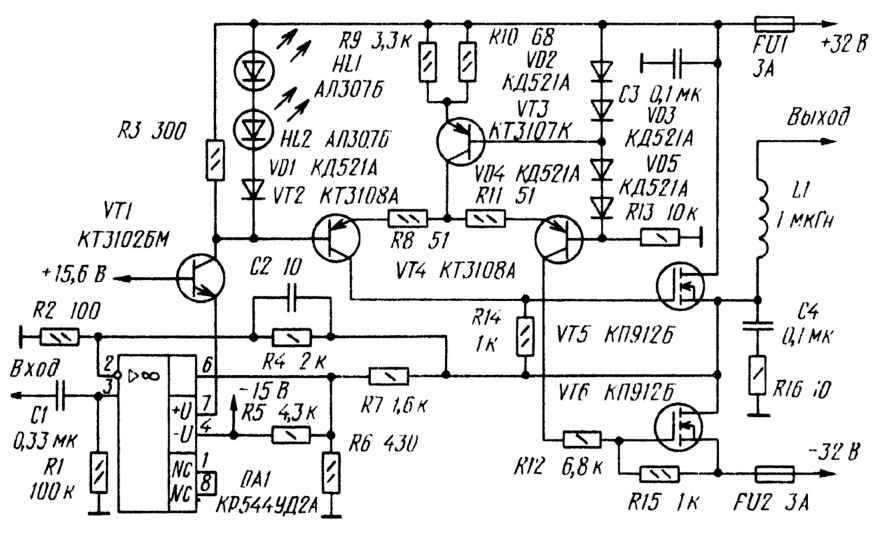
High-quality power amplifier
When designing the amplifier described below, the amplifier "KVOD-405" was used as a basis, successfully combining high technical characteristics and circuit simplicity. The block diagram of the amplifier basically remained unchanged, only devices protecting transistors of the output stage from overload are excluded. Practice has shown that devices of this kind do not exclude completely failures of transistors, but often introduce nonlinear distortions at maximum output power. The current of the transistors can be limited, and otherwise, for example, using the overcurrent protection in voltage regulators. At the same time, it seems reasonable to protect the loudspeakers in the event of an amplifier failure or power supplies. To improve the symmetry of the amplifier, the output stage is made on a complementary pair of transistors, and diodes VD5, VD6 are included between the bases of the transistors VT9, VT10 to reduce the nonlinear distortions of the "step" type. At the same time, a sufficiently reliable closing of the output stage transistors in the absence of a signal is ensured. The input circuit has been slightly changed. The non-inverting DA input DA1 was used as the signaling input, which allowed increasing the input resistance of the amplifier (it is determined by the resistance of the resistor R1 and is equal to 100 kOhm). It should be noted, however, that in the non-inverting variant the stability of the amplifier remains high. To prevent clicks in the loudspeakers due to transients during power-up, and to protect the loudspeakers from DC voltage in the event of failure of the amplifier or power supplies, a simple, well-proven device (VT6-VT8) used in the industrial amplifier Brig-001 ". When this device is triggered, one of the HL1, HL2 lamps lights up, signaling the presence of a voltage of one or another polarity at the output of the amplifier. In general, the circuit of the described amplifier does not differ from the amplifier circuit "Kvod -405". The coils are wound with a PEV-2 wire 1.0 on frames with a diameter of 10 mm and contain: L1 and L3 - 50 turns (inductance - 5 ... 7 μH), L2 - 30 turns (3 μH).
Instead of those indicated on the circuit in the amplifier, you can use the OU K574UD1B, K574UD1V, K544UD2, and (with some degradation of the parameters) K544UD1 and K140UD8A - K140UD8V; transistors KT312V, KT373A (VT2), KT3107B, KT3107I, KT313B, KT361V, KT361K (VT1, VT3, VT4), KT315V (VT6, VT8), KT801A, KT801B (VT7). Each of the transistors KT825G can be replaced by the composite transistors KT814B, KT814G + KT818V, KT818G, and KT827A -composite transistors KT815B, KT815G + KT819V, KT819G. Diodes VD3 - VD6, VD11, VD12 - any silicon with a maximum direct current of at least 100 mA, VD7 - VD10 - the same, but with a maximum current of not less than 50 mA. In the absence of zener diodes KS515A it is permissible to use zener diodes D814A, D814B or KS175A connected in series.
The maximum output power, W, at a load of 4 Ohm ..... 2x70
Rated input voltage, V ..................................... 0.2
The upper limit of the frequency range, kHz .................................... 50
Rate of increase in output voltage, V / μs .............. 5.5
Signal-to-noise ratio (unweighted), dB ............................... 80
Harmonic coefficient,%, not more, ........................................ 0, 05
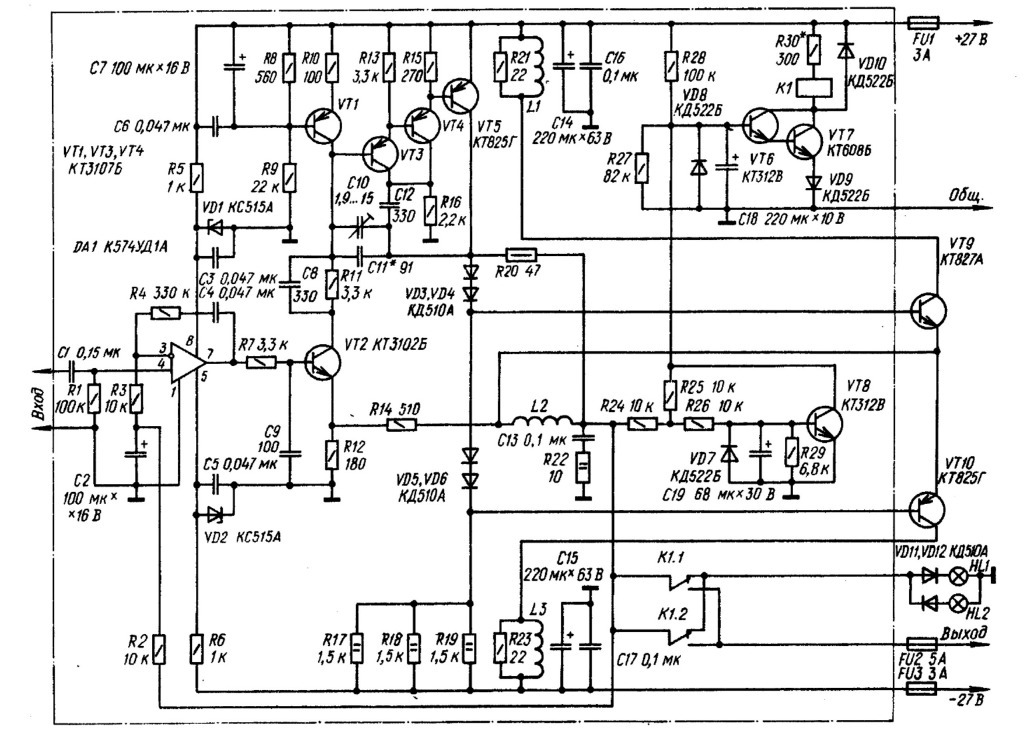
Amplifier with multi-loop OOS
Main technical characteristics:
Nominal frequency range, Hz, ...................... 20 ... 20000
Rated load resistance, Ohm ............................................... 4
Nominal (maximum) output. power, W, at load resistance, Ohm:
4 .................................................................................. 70(100)
8 ........................................................................................40(60)
Frequency range, Hz, ............................................. ......... 5 ... 100000
Rate of increase in output voltage, V / μs, not less than ... 15 Harmonic coefficient,%, no more, at frequency, Hz:
20...5000 .................................................................................. 0,001
10000 ................................................................................ 0,003
20000 ................................................................................. 0,01
Harmonics factor,%, not more, ...................................... .01
Rated input voltage, V .......................................... 1
Input resistance, kOhm, not less, ............... 47
The first stage is assembled on an operational amplifier DA1, the rest are on transistors (the second and third are on VT1, VT3, the fourth on VT8, VT11 and VT10, VT12, the fifth on VT13, VT14). In the fourth (pre-finite) stage, transistors of different structure were used, switched on according to the scheme of a composite emitter follower, which allowed introducing a local OOS into it and thus increase linearity and reduce the output resistance. To reduce transient distortion at high frequencies, the output stage operates in the AV mode, and the resistance of the bias resistors (R30, R33) is limited to 15 Ω. All transistor stages of the amplifier are covered by a circuit of a local OOS with a depth of at least 50 dB. The voltage of the OOS is removed from the amplifier output and through the divider R10R12 is fed to the emitter circuit of the transistor VT1. The frequency correction and stability along the OO circuit are provided by the capacitor C4. The introduction of local OOS allowed even with the most unfavorable combinations of amplifying properties of transistors to limit the harmonic coefficient of this part of the amplifier by 0.2%. The protection device consists of a trigger on transistors VT6, VT7 and a threshold element on transistor VT9. As soon as the current through any of the output transistors exceeds 8 ... 9 A, the transistor VT9 opens, and its collector current opens the transistors of the trigger VT6, VT7.
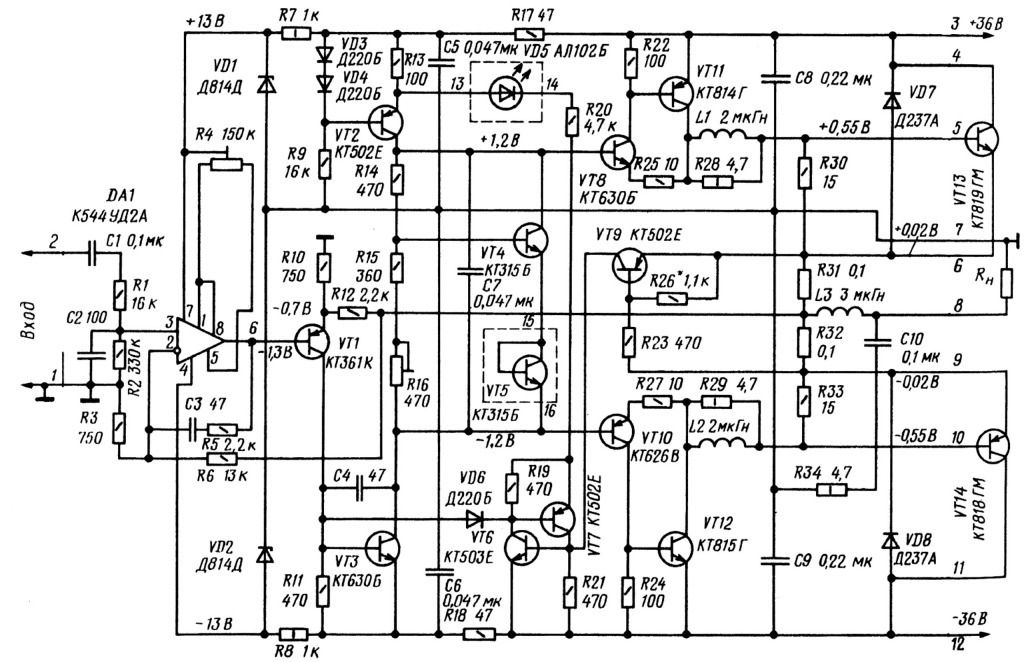
Power amplifier
The RF amplifier offered to attention of radio amateurs has very low coefficients of harmonic and intermodulation distortion, it is relatively simple, capable of withstanding a short-term short circuit in the load, does not require remote elements of thermal stabilization of the current of the transistors of the output cascade.
Main technical characteristics:
Maximum power on the load 4 Ohm, W ........................... 80
Nominal frequency range, Hz ...................... 20 .... 20000
The harmonic coefficient at the maximum output power of 80 W,%, at the frequency:
1 kHz ................................................ ................................. 0.002
20..................................................................................... 0,004
Intermodulation distortion factor,% .................. 0.0015
Rate of increase in output voltage, V / μs ..................... 40
In order to increase the input resistance, transistors VT1, VT2 are introduced into the amplifier. This facilitated the operation of the DA1 DA and allowed to provide a stable base-emitter voltage of transistors VT3, VT4 with temperature change.
Resistor R14 establishes the symmetry of the arms of the output stage of the amplifier. 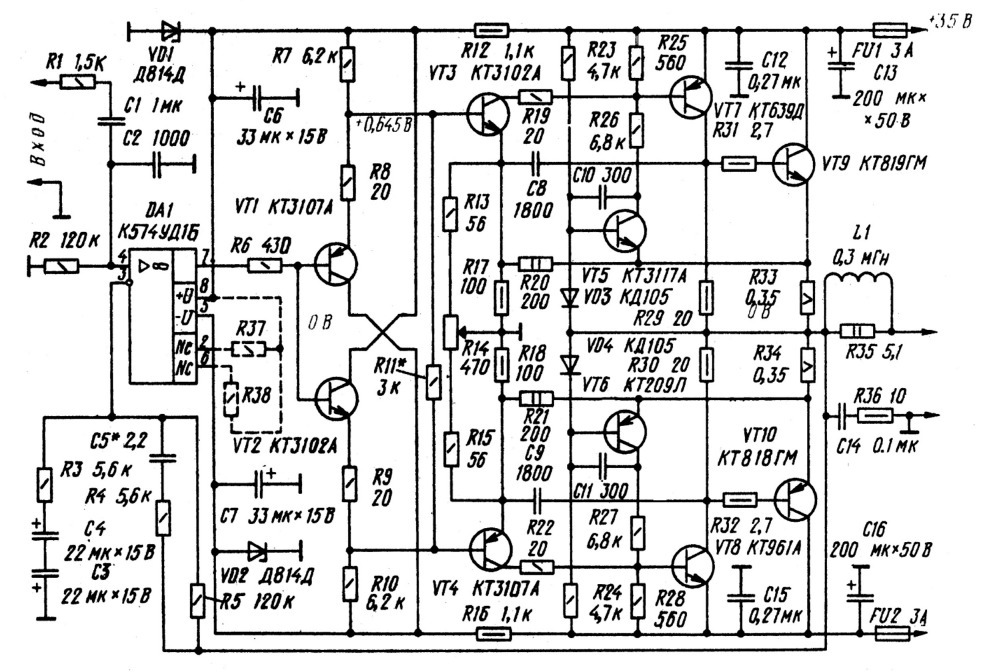
Simple power amplifier
Main technical characteristics:
Input voltage, V .............................................. ................ 1.8
Input resistance, kΩ .................................................. .......10
Nominal output power, W, ......................................... 90
Nominal frequency range, Hz ..................... 10 ... 20000
Harmonics factor,%, at frequency, Hz:
200 .................................................................................... 0,01
2000 ............................................................................ 0,018
20000 ............................................................................... 0,18
Relative noise level, dB, no more ......................... -90
Rate of increase in output voltage, V / μs ................. 17
The power amplifier consists of a cascade of voltage amplification on a high-speed op-amp DA1 and an output stage on transistors VT1-VT4. Transistors of the complementary pair of the pre-termed cascade (VT1 - VT2) are connected in a common-base circuit, and the terminal (VT3-VT4) with a common emitter. Such inclusion of powerful composite transistors of the final stage provides amplification of a signal not only on a current, but also on a voltage. The symmetry of the arms of the output stage contributes to the reduction of the nonlinear distortions introduced by the amplifier. For the same purpose, it is covered by a common OOS circuit, the voltage of which is removed from the output of the amplifier and is applied to the non-inverting input of the op-amp through the resistor R3. Condensers C4, C5, shunt resistors R6, R7 reduce the distortion of the "step" type. The circuit R12C6 prevents self-excitation of the amplifier in the region of higher sound frequencies and increases the stability of its operation with the reactive nature of the load. The gain depends on the ratio of resistors R2, R3. At the nominal values indicated on the diagram it is equal to 10.
To power the amplifier, any unstabilized bipolar source with a voltage of 25 ... 45 V can be used. Instead of KT503D transistors, it is possible to use KT503E, instead of KT502D - KT502E. Transistors KT827B and KT825D can be replaced by the components of the transistors KT817G + KT819GM and KT816G + KT818GM, respectively.
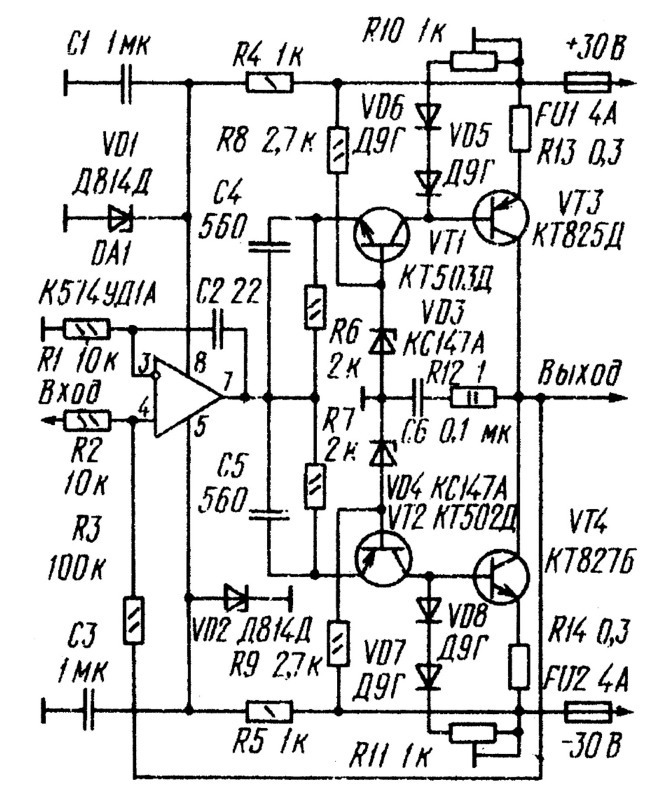
Power Amplifier 200 W with Power Supply
Main technical characteristics:
Nominal frequency range, Hz ..................... 20 ... 20000
Maximum output power, W, at 4 Ohm load ........ 200
Harmonics factor,%, at an output power of 0.5..150 W on the frequency, kHz
1 ..........................................................................................0,1
10 .................................................................................... 0,15
20 .................................................................................... 0,2
Efficiency,% ............................................... .............................................. 68
Rated input voltage, V ............................................ 1
Input resistance, kΩ .................................................. .. 10
Rate of increase in output voltage, V / μs ................... 10
The pre-amplification stage is executed on a high-speed DA1 (K544UD2B) op-amp, which, along with the necessary voltage gain, ensures stable operation of the amplifier with deep OOS. The feedback resistor R5 and the resistor R1 determine the amplification factor of the amplifier. The output stage is made on transistors VT1 - VT8. Zener diodes VD1, VD2 stabilize the supply voltage of the op-amp, which is simultaneously used to create the necessary bias voltage of the output stage. Capacitors C4, C5-correcting. With increasing capacitance of capacitor C5, the stability of the amplifier increases, but at the same time nonlinear distortions increase, especially at higher sound frequencies. The amplifier remains operational when the supply voltage drops to 25 V.
As a power supply, you can use a conventional bipolar power supply, the circuit diagram of which Powerful composite transistors VT7 and VT8, included in the circuit of emitter followers, provide a sufficiently good filtering of power supply pulses with the network frequency and stabilization of the output voltage due to the stabilizers VD5 - VD10. Elements L1, L2, R16, R17, C11, C12 eliminate the possibility of high-frequency generation. Resistors R7, R12 of the power supply are a piece of copper wire PEL, PEV-1 or PELSHO with a diameter of 0.33 and a length of 150 mm wound on the case of a resistor MLT-1. The power transformer is made on a toroidal magnetic core made of E320 electrical steel, 0.35 mm thick, 40 mm tape width, 80 magnetic core internal diameter, 130 mm outer diameter. The network winding contains 700 turns of PELSHO 0.47 wire, secondary - 2x130 turns of PELSHO wire 1,2 mm.
Instead of OU K544UD2B you can use K544UD2A, K140UD11 or K574UD1. Each of the transistors KT825G can be replaced by the composite transistors KT814G, KT818G, and KT827A-component transistors KT815G, KT819G. Diodes VD3 - VD6 UMZCH can be replaced by any high-frequency silicon diodes, VD7, VD8 - any silicon with a maximum direct current of at least 100 mA. Instead of stabilizers KS515A, it is possible to use zener diodes D814A (B, B, D, D) and KS512A connected in series.
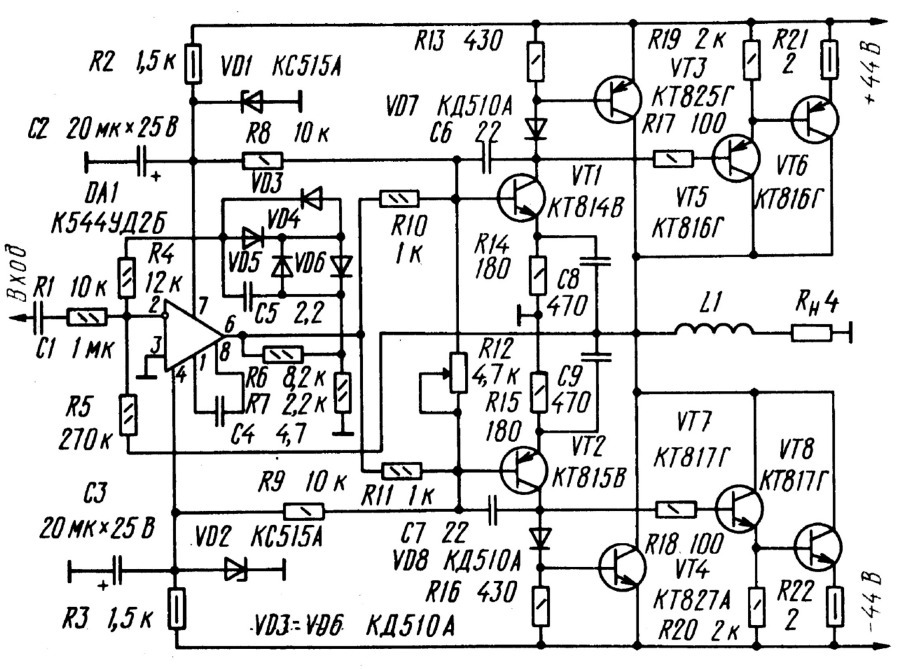
BP
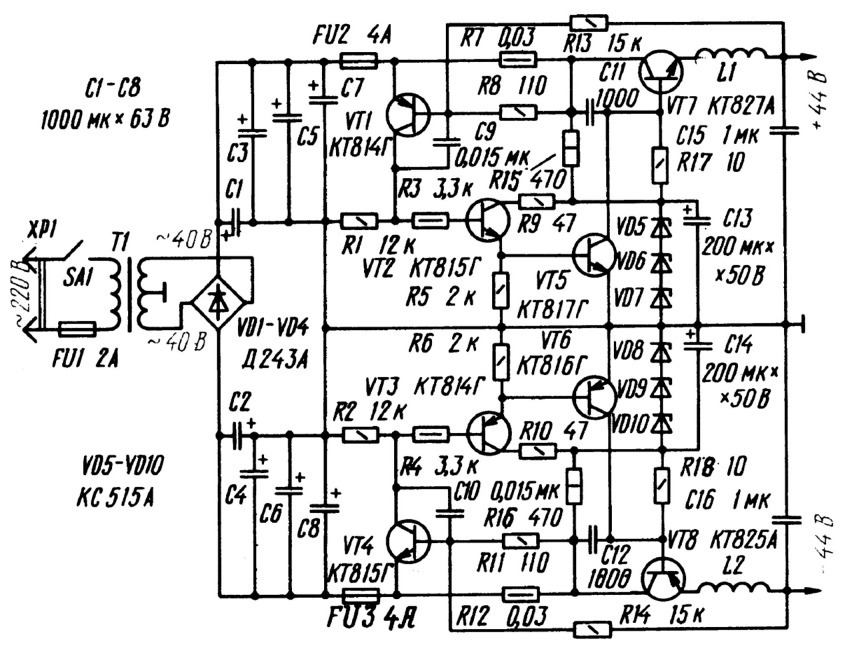
After mastering the basics of electronics, a novice radio amateur is ready to solder his first electronic designs. Amplifiers of power of sound frequency, as a rule the most repeatable designs. Schemes are quite numerous, each differing in its parameters and design. In this article, we will consider several of the simplest and fully operational amplifier circuits that can be successfully repeated by any radio amateur. The article does not use complicated terms and calculations, everything is simplified as much as possible so that there are no additional questions.
Let's start with a more powerful scheme.
So, the first scheme is made on the well-known TDA2003 chip. This is a mono amplifier with an output power of up to 7 watts per 4 ohm load. I want to say that the standard circuit for the inclusion of this chip contains a small number of components, but a couple of years ago I invented a different circuit on this chip. In this scheme, the number of components is minimized, but the amplifier has not lost its sound parameters. After the development of this scheme, all its amplifiers for low-power speakers began to do just this scheme.
The circuit of the presented amplifier has a wide range of reproducible frequencies, a range of supply voltages from 4.5 to 18 volts (typical 12-14 volts). The chip is installed on a small heat sink, since the maximum power reaches up to 10 watts.
The chip is capable of operating at a load of 2 ohms, which means that 2 heads with a resistance of 4 ohms can be connected to the output of the amplifier.
The input capacitor can be replaced by any other one, with a capacitance of 0.01 to 4.7 μF (preferably 0.1 to 0.47 μF), both film and ceramic capacitors can be used. All other components should not be replaced.
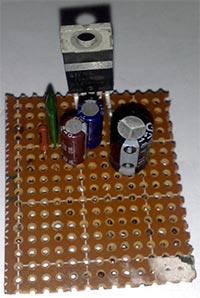
Volume control from 10 to 47 kOhm.
The output power of the chip allows it to be used in low-power computers for PCs. It is very convenient to use a microcircuit for stand-alone speakers to a mobile phone, etc.
The amplifier works right after switching on, does not need additional setup. It is advised to add a minus supply to the heat sink. All electrolytic capacitors should be used at 25 volts.
The second circuit is assembled on low-power transistors, and is more suitable as an amplifier for headphones.
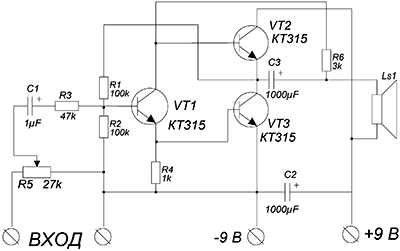
This is probably the best quality circuit of this kind, the sound is clean, the entire frequency spectrum is felt. With good headphones, it feels like you have a full-bodied subwoofer.
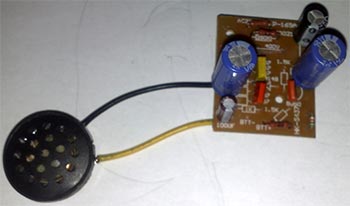
The amplifier was assembled with only 3 reverse-conduction transistors, as the cheapest option, the KT315 series transistors were used, but their choice is quite wide.
The amplifier can work on a low-ohmic load, up to 4 ohms, which makes it possible to use a circuit to amplify the signal of the player, radio receiver, etc. As a power source, a 9-volt krona battery is used.
The final cascade also uses transistors KT315. To increase the output power, you can use the transistors KT815, but then you have to increase the supply voltage to 12 volts. In this case, the power of the amplifier will reach 1 Watt. The output capacitor can have a capacitance of 220 to 2200 μF.
The transistors in this circuit do not heat up, therefore, some cooling is not necessary. When using more powerful output transistors, you may need small heat sinks for each transistor.
And finally - the third scheme. A no less simple but proven version of the structure of the amplifier is presented. The amplifier is capable of operating from a lower voltage to 5 volts, in this case the output power of the UM will not exceed 0.5 W, and the maximum power at a power supply of 12 volts reaches up to 2 watts.
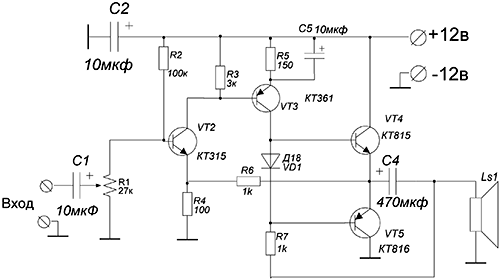
The output stage of the amplifier is built on the domestic complementary pair. Adjust the amplifier by selecting resistor R2. To do this, it is desirable to use a trimmer for 1kΩ. Slowly turn the regulator until the quiescent current of the output stage is 2-5 mA.
The amplifier does not have a high input sensitivity, so it is advisable to use a preamplifier before entering.

A very important role in the circuit is played by a diode, it is here to stabilize the output cascade mode.
Transistors of the output stage can be replaced by any complementary pair of corresponding parameters, for example, KT816 / 817. The amplifier can supply low-power standalone speakers with a load resistance of 6-8 ohms.
Today it is no longer fashionable to solder different shiny parts on a homemade circuit board, as it was about twenty years ago. However, in our cities there are still circles of radio amateurs, specialized magazines are being issued in offline and online modes.
Why did interest in radio electronics fall sharply? The fact is that in modern stores everything that is required is realized, and there is no need to study anything or search for ways to acquire it.
But not everything is as simple as we would like. On sale there are excellent speakers with active amplifiers and subwoofers, wonderful imported stereo systems and multichannel mixers with a wide range of possibilities, but there are no low power amplifiers. Usually they are used to connect instruments at home, so as not to destroy the psyche of neighbors. Buying a device as part of a powerful device is rather expensive, the rational solution will be the following: a little bit of stalling and creating a self-made amplifier without help. Fortunately, today it is possible, and my uncle, the Internet in this with pleasure will help.
The amplifier "assembled on the knee" 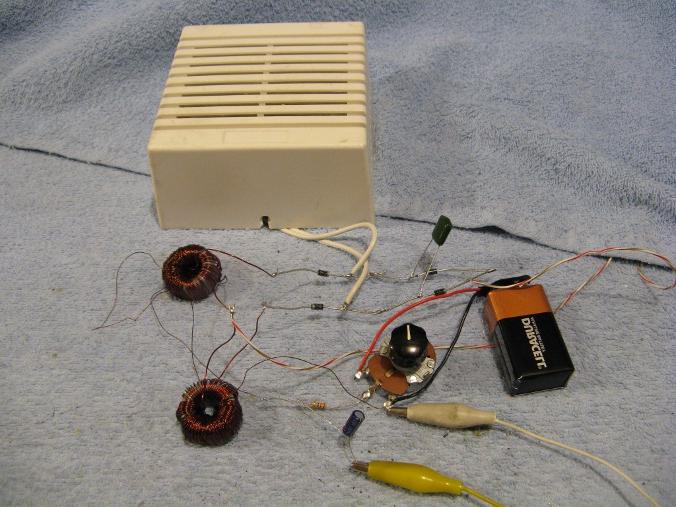 Attitude to the self-assembled instruments today is somewhat negative, and the expression "collect on the knee" is excessively negative. But we will not listen to envious people, but immediately turn to the first stage.
Attitude to the self-assembled instruments today is somewhat negative, and the expression "collect on the knee" is excessively negative. But we will not listen to envious people, but immediately turn to the first stage. 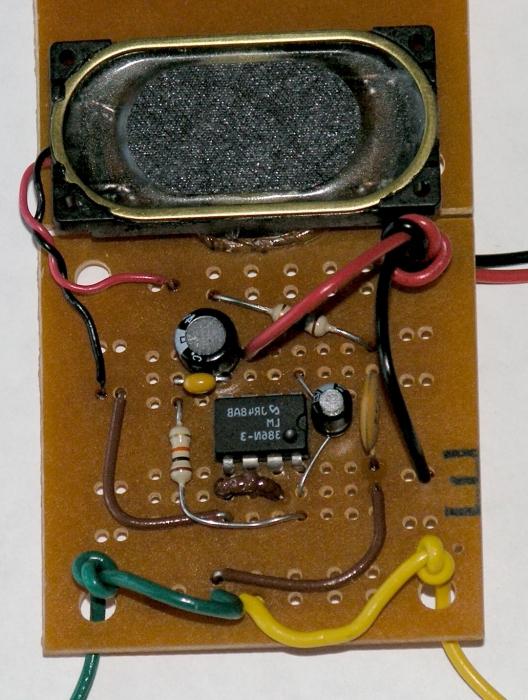 Initially, you must select a schema. Homemade type ULF can be done on transistors or a microchip. The first option is highly discouraged by novice radio amateurs, as the board is cluttered, and the repair of the device will become more complicated. It is best to replace a dozen transistors with one monolithic chip. Such a self-made amplifier will please the eye, it will turn out to be compact, and it will take a little time to assemble it.
Initially, you must select a schema. Homemade type ULF can be done on transistors or a microchip. The first option is highly discouraged by novice radio amateurs, as the board is cluttered, and the repair of the device will become more complicated. It is best to replace a dozen transistors with one monolithic chip. Such a self-made amplifier will please the eye, it will turn out to be compact, and it will take a little time to assemble it.
To date, the most popular and reliable is the TDA2005 chip. It is already in itself a two-channel ULF, it is enough just to organize power and provide input and output signals. Such a simple homemade amplifier will cost no more than a hundred rubles, along with other details and wires.
The output power of the TDA2005 is between 2 and 6 watts. This is enough for listening to music at home. The list of used parts, their parameters and, in fact, the circuit itself is shown below.
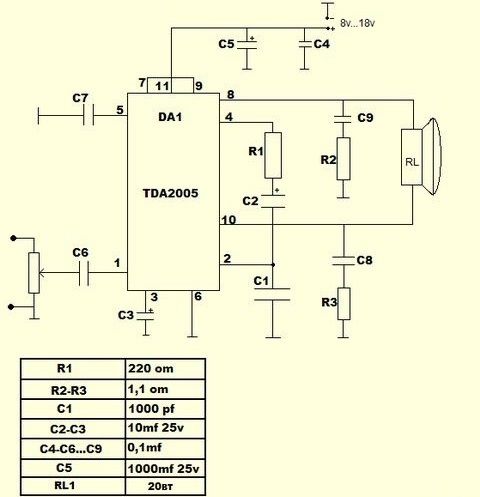 When the device is assembled, it is recommended to screw a small aluminum screen to the chip. Thus, when heated, the heat will dissipate better.
When the device is assembled, it is recommended to screw a small aluminum screen to the chip. Thus, when heated, the heat will dissipate better.
This self-made amplifier is powered by 12 volts. For its implementation, a small power supply unit or an electric adapter with the ability to switch output voltage values is purchased. The current of the device is not more than 2 amps.
To this ULF-amplifier you can connect speakers up to 100 watts. The input of the amplifier can be signaled from a mobile phone, DVD player or computer. At the output, the signal is removed through a standard jack under the headphones.
So, we figured out how to assemble the amplifier in a short time for small money. The rational decision of practical people!
Good day, dear hrabriuzer, I want to tell you about the basics of building audio frequency amplifiers. I think this article will be interesting to you if you have never studied radio electronics, and of course it will be ridiculous to those who do not part with the soldering iron. And so I'll try to talk about this topic as simply as possible and, unfortunately, omitting some nuances.An audio amplifier or a low-frequency amplifier, in order to understand how it all works and why there are so many transistors, resistors and capacitors, you need to understand how each element works and to try to find out how these elements are arranged. In order to assemble a primitive amplifier we need three kinds of electronic elements: resistors, capacitors and of course transistors.
Resistor
So, the resistors are characterized by resistance to the electric current and this resistance is measured in Ohms. Each electrically conductive metal or alloy of metals has its own resistivity. If we take a wire of a certain length with a large resistivity, then we will get a very real wire resistor. In order for the resistor to be compact, the wire can be wound onto the frame. So we will get a wire resistor, but it has a number of drawbacks, so the resistors are usually made of cermet material. Here are the resistors on the electrical circuits:The upper version of the designation is adopted in the US, the lower one in Russia and in Europe.
Capacitor
The capacitor consists of two metal plates separated by a dielectric. If we apply a constant voltage to these plates, an electric field will appear, which after the power failure will support positive and negative charges on the plates, respectively.
The basis of the design of the capacitor is two current-conducting plates, between which there is a dielectric
Thus, the capacitor is able to accumulate electric charge. This ability to accumulate an electrical charge is called an electrical capacitance, which is the main parameter of the capacitor. The electric capacity is measured in Farad. What is even more characteristic is that when we charge or discharge a capacitor, an electric current flows through it. But as soon as the capacitor is charged, it stops transmitting electric current, and this is because the capacitor took charge of the power source, that is, the potential of the capacitor and the power source are the same, and if there is no potential difference (voltage), there is no electric current. Thus, a charged capacitor does not pass a constant electric current, but passes an alternating current, since when it is connected to an alternating electric current, it will be constantly charged and discharged. On electric schemes it is designated as follows:
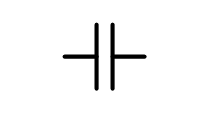
Transistor
In our amplifier we will use the simplest bipolar transistors. The transistor is made of a semiconductor material. The material we need for us is the presence of free carriers of both positive and negative charges. Depending on what kind of charges are larger, semiconductors are distinguished into two types of conductivity: n-type and p-type (n-negative, p-positive). Negative charges are the electrons released from the outer shells of the atoms of the crystal lattice, and the positive charges are the so-called holes. Holes are vacant places that remain in the electron shells after the electrons leave them. Conditionally, we will designate atoms with an electron on an external orbit in a blue circle with a minus sign, and atoms with a vacant space - an empty circle: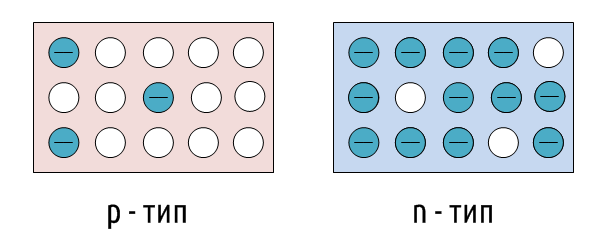
Each bipolar transistor consists of three zones of such semiconductors, these zones are called the base, emitter and collector.

Let us consider an example of the operation of a transistor. To do this, connect to the transistor two batteries of 1.5 and 5 volts, plus to the emitter, and a minus to the base and the collector, respectively (see the figure):
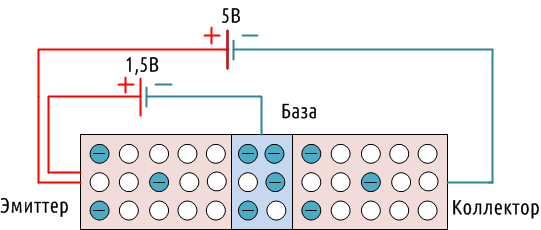
At the base and emitter contact, an electromagnetic field appears, which literally snatches electrons from the outer orbit of the base atoms and transfers them to the emitter. Free electrons leave holes behind them, and occupy vacant positions already in the emitter. The same electromagnetic field has the same effect on the atoms of the collector, and since the base in the transistor is thin enough relative to the emitter and collector, collector electrons easily pass through it to the emitter, and in much more than from the base.
If we turn off the voltage from the base, then there will be no electromagnetic field, and the base will act as a dielectric, and the transistor will be closed. Thus, when a sufficiently low voltage is applied to the base, we can control the higher applied voltage to the emitter and collector.
The transistor considered by us pnp-type, since he has two p-zone and one n-zone. There are also npntransistors, the principle of operation in them is the same, but the electric current flows in them in the opposite direction, than in the transistor considered by us. That's how bipolar transistors are indicated on electrical circuits, the arrow indicates the direction of the current: 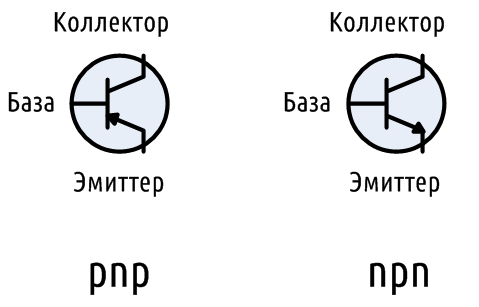
ULF
Well, let's try to design a low-frequency amplifier from this. To begin with, we need a signal that we will amplify, it can be a computer sound card or any other audio device with a linear output. Let's assume our signal with a maximum amplitude of about 0.5 volts at a current of 0.2 A, approximately the following: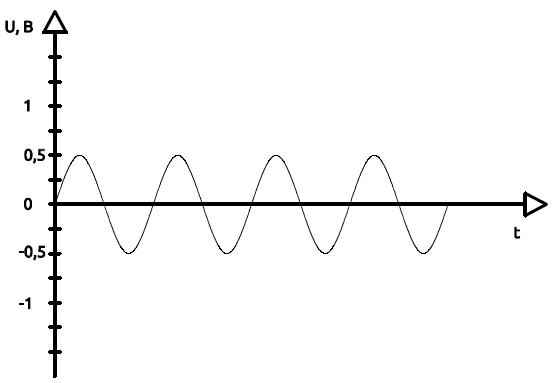
And what would have earned the most simple 4-ohm 10-watt speaker, we need to increase the amplitude of the signal to 6 volts, with the current I = U / R = 6/4 = 1.5 A.
So, let's try to connect our signal to the transistor. Remember our circuit with a transistor and two batteries, now instead of a 1.5 volt battery we have a line-out signal. Resistor R1 serves as a load, so that there is no short circuit and our transistor does not burn.
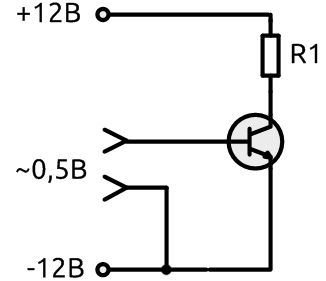
But there are two problems at once, firstly our transistor npntype, and opens only if the half-wave is positive, and when it is negative, it closes.
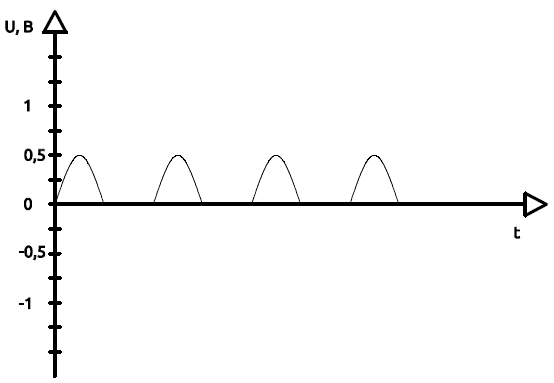
Secondly, the transistor, like any semiconductor device, has non-linear characteristics with respect to voltage and current and the lower the current and voltage values, the stronger these distortions are:
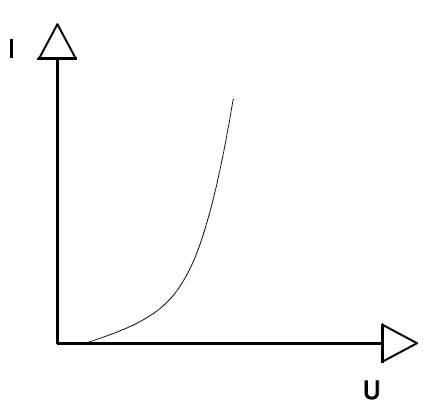
Not only that from our signal there was only a half-wave, so it will also be distorted:
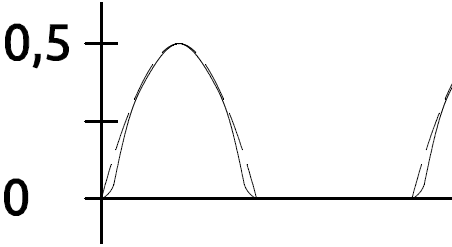
This is the so-called step-type distortion.
To get rid of these problems, we need to shift our signal to the working area of the transistor, where the entire sinusoid of the signal will fit and the nonlinear distortions will be negligible. To do this, apply a bias voltage to the base, say 1 volt, using a voltage divider composed of two resistors R2 and R3.
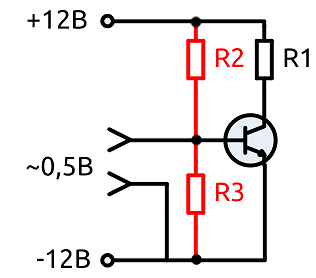
And our signal entering the transistor will look like this:
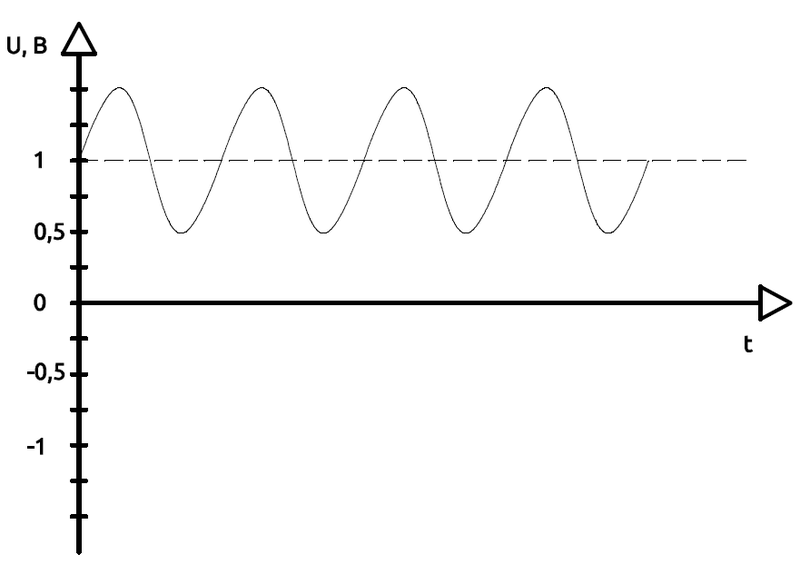
Now we need to remove our useful signal from the collector of the transistor. To do this, set the capacitor C1:
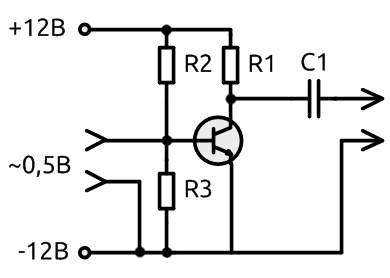
As we remember, the capacitor passes an alternating current and does not miss a constant current, so it will serve us as a filter letting through only our useful signal - our sinusoid. A constant component that does not pass through the capacitor will be dissipated by resistor R1. The alternating current, our useful signal, will tend to pass through the capacitor, so the resistance of the capacitor for it is negligible compared to the resistor R1.
So we got the first transistor cascade of our amplifier. But there are two more small nuances:
We do not know at 100% what signal enters the amplifier, all of the same the source of the signal is faulty, everything happens, again static electricity or with a useful signal passes a constant voltage. This may cause the transistor to malfunction or even cause it to malfunction. To do this, we install a capacitor C2, like a capacitor C1 it will block a constant electric current, and also a limited capacitance of the capacitor will not pass the peaks of large amplitude that the transistor can spoil. Such power surges typically occur when the device is turned on or off.
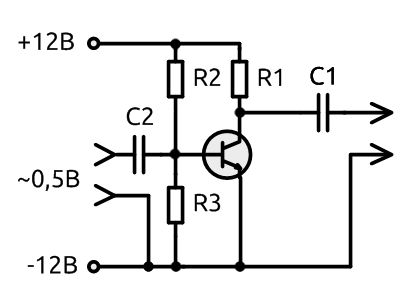
And the second nuance, any signal source requires a certain specific load (resistance). Therefore, the input resistance of the cascade is important for us. To adjust the input resistance, add the resistor R4 to the emitter circuit:
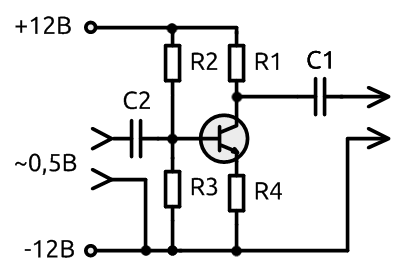
Now we know the purpose of each resistor and capacitor in the transistor cascade. Let's now try to calculate what face values should be used for it.
Initial data:
- U = 12 V - supply voltage;
- U be ~ 1 V - Voltage emitter-base of the operating point of the transistor;
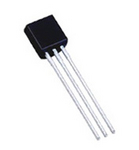
- P max = 200 mW - maximum power dissipation;
- I max = 100 mA - the maximum direct current of the collector;
- U max = 18 V - maximum allowable collector-base / collector-emitter voltage (We have a supply voltage of 12 V, so there is enough with a margin);
- U eb = 5 V - maximum permissible emitter-base voltage (our voltage is 1 volt ± 0.5 volts);
- h21 = 75-225 - base current amplification factor, the minimum value is assumed to be 75;
- We calculate the maximum static power of the transistor, it is taken 20% less than the maximum dissipated power, so that our transistor does not work at the limit of its capabilities:
P st.max = 0,8*P max = 0.8 * 200mW = 160 mW;
- Define the collector current in the static mode (without a signal), in spite of what the base does not supply voltage through the transistor, the electric current still flows to a small extent.
I k0 = P st.max / U keh, where U keh - collector-emitter voltage. The transistor dissipates half of the supply voltage, the second half will be dissipated by resistors:
U keh = U / 2;
I k0 = P st.max / (U / 2) = 160 mW / (12V / 2) = 26.7 mA;
- Now calculate the load resistance, initially we had one resistor R1, which performed this role, but since we added a resistor R4 to increase the input resistance of the cascade, now the load resistance will be composed of R1 and R4:
R n = R1 + R4, where R n - total load resistance;
The ratio between R1 and R4 is usually taken as 1 to 10:
R1 = R4*10;
Calculate the load resistance:
R1 + R4 = (U / 2) / I k0 = (12V / 2) / 26.7 mA = (12V / 2) / 0.0267 A = 224.7 ohms;
The nearest resistors are 200 and 27 Ohm. R1 = 200 Ohm, and R4 = 27 Ohm.
- Now find the voltage on the collector of the transistor without a signal:
U k0 = (U кэ0 + I k0 * R4) = (U - I k0 * R1) = (12V-0.0267 A * 200 Ohm) = 6.7 V;
- Current base of the transistor control:
I b = I to / h21, where I to - Collector current;
I to = (U / R n);
I b = (U / R n) / h21 = (12V / (200 ohm + 27 ohms)) / 75 = 0.0007 A = 0.07 mA;
- The total base current is determined by the bias voltage on the base, which is set by the divider R2 and R3. The current given by the divider should be 5-10 times greater than the current of the base control ( I b), so that the actual control current of the base does not affect the bias voltage. Thus, for the current value of the divider ( I of cases) we accept 0.7 mA and calculate R2 and R3:
R2 + R3 = U / I of cases = 12V / 0.007 = 1714.3 Ohm
- Now calculate the voltage on the emitter in the rest state of the transistor ( U э):
U э = I k0 * R4 = 0,0267 A * 27 Ohm = 0,72 V
Yes, I k0 the quiescent current of the collector, but the same current passes through the emitter, so I k0 consider the resting current of the whole transistor.
- We calculate the total voltage on the base ( U b) taking into account the bias voltage ( U cm = 1B):
U b = U э + U cm = 0.72 + 1 = 1.72 V
Now, using the voltage divider formula, we find the values of the resistors R2 and R3:
R3 = (R2 + R3) * U b / U = 1714.3 Ω * 1.72 V / 12 V = 245.7 Ω;
The nearest resistor rating is 250 Ohms;
R2 = (R2 + R3) - R3 = 1714.3 Ω - 250 Ω = 1464.3 Ω;
The nominal resistor is selected in the direction of reduction, the nearest R2 = 1.3 kOhm.
- Capacitors C1 and C2 usually set at least 5 μF. The capacitance is selected so that the capacitor can not recharge.
Conclusion
At the output of the cascade, we obtain a proportionally amplified signal both for current and voltage, that is, for power. But one cascade is not enough for the required gain, so we'll have to add the next and the next ... And so on.The considered calculation is rather superficial and such amplification circuit certainly is not used in the structure of amplifiers, we must not forget about the range of transmitted frequencies, distortions and much more.
